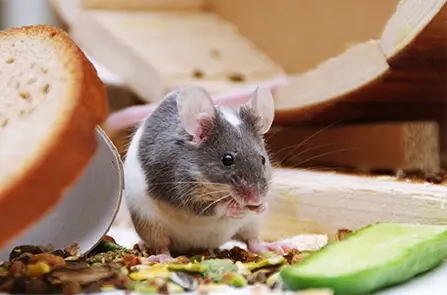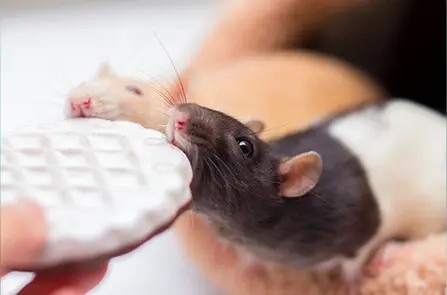Types OF Mus Musculus

Mus Musculus or House Mouse are considered rodents with a widespread distribution across the globe. These little creatures are commonly found in urban areas closely related to humans. Besides this, they can be found in cracks in the ground, parts of buildings, or caves. The population of these rodents increases rapidly because they can reproduce abundantly. These opportunistic feeders have various species, types, and subspecies, each with a unique appearance and color. Because of their different species, these little creatures have become a center of attention for pet enthusiasts.
Let’s minimize your curiosity and uncover some common Mus Musculus types.
1. African pygmy mouse
These rodents are also called Mus Minutoides. These are the tiniest mice that are found in Sub-Saharan Africa and are agile climbers. It is essential to keep them in pairs or groups because they need social interaction to grow. The interesting fact about these rodents is that they are exotic and stay active during the night and day. The color of these mice varies from gray to brick red, and they have triangular ears.
2. Steppe mouse
They are also known as mound-building mice, having the scientific name Mus Spicilegus. Generally, these mice are found in gray colors, but sometimes, they are also bicolored with a paler lower belly. As compared to other species, their tail is slender. The appearance of these little creatures is almost similar to that of the common house mouse; therefore, it is difficult to differentiate them. Their length ranges between 70-80mm, along with a tail that is about 55mm long.
3. Little Indian Field Mouse
The Mus Booduga are little rodents that can be found in the regions of India, such as Bangladesh, Sri Lanka, and Nepal.Their length is 7 cm along with a tail that is 6 cm long. The large rounded ears, curved incisors, and dark tails are included in the appearance of these pets. They reproduce throughout the year and have at least 1-13 babies per litter. These rodents are generalist feeders and stay active during the night.
4. Ryukyu Mouse
The scientific name of these rodents is Mus Caroli. The regions where these little rodents can be found include China, Cambodia, Japan, and Indonesia. The length of these rodents ranges between 12-15 cm without including their tail. The body of these rodents is covered with soft fur and has a rounded shape. Their tail is about 5-6 cm, and their fur color varies from brown, gray, white, or black. The eyes and ears of these mice are relatively smaller.

5. Algerian Mouse
The Mus Spretus is considered a wild species of mouse that is native to the Western Mediterranean. These little creatures are also known as the western Mediterranean mouse, and their appearance is almost similar to the house mouse but can be distinguished from their shorter tail. They have brownish fur, and their head-body length ranges between 7-9 cm with a body weight of about 15-19g. They are opportunistic and omnivorous feeders; therefore, they can eat grass, plants, fruits, and meat.
6. Gairdner's Shrewmouse
The shrewmouse or Mus Pahadi is a type of Musculus that can be found in China, India, Thailand, and Vietnam. They are also known as Sikkim mice, and their size is about 10-13 cm. Their body is slender with shorter legs, and their denser fur helps in insulation. The most noticeable characteristic of these rodents is their tail, which is as long as their body itself. It provides them with balance and helps in communication. Their fur shade is brown and the lower side of their belly is lighter in color.
7. Flat-haired Mouse
The regions where Mus Platythrix can be found is South and Central India. These are considered as the largest mouse having a weight about 18 grams. Their body is 10-12 cm along with a tail that is 7-8 cm. Their tail is a little thin and their fur is soft with a grayish brown color. They are nocturnal and agile climbers. Beside this they are prolific breeders which means they can produce multiple litters per year.
8. Cypriot Mouse
They are known as the Mus Cypriacus, which can be found on the island of Cyprus in the Eastern Mediterranean. In 2004, these species were first recognized. The bigger ears, eyes, and teeth of these creatures differentiate them from their other species. They are relatively smaller in size, ranging from 6-9 cm. The fur of these rodents is grayish brown, and they have longer tails with thin fur.
9. Macedonian Mouse
These rodents are also known as Mus Macedonicus, which are distributed from Eastern Georgia to western Bulgaria and Israel. These pets are also included in the Palearctic group. The weight of these little rodents is about 15 grams. The color of these pets varies from dark brown to light brown and reddish brown shades. There are tiny hairs in white colors on their ears. The tail is bicolor, which means it is dark brown on the upper side and lighter on the lower side. White hair is present on the top of their feet.
10. Servant Mouse
These mice are also called Bonhote mice. The regions to find these little creatures is western ghats of South India. They are terrestrial or nocturnal mice that can survive in dry lowland grassland and forests. Because of habitat destruction these mice have been considered endangered since 1996.
11. Free State Pygmy Mouse
The native habitat of Mus Orangiae or orange mouse is Lesotho and South Africa. The natural habitats where these rodents can survive are grassland, pastureland, and arable land. The appearance of these mice includes a pointed snout, large ears, and short tails. Besides this, they are nocturnal and omnivorous pets that can feed both plants and meat. They are also facing threats because of habitat loss. Their fur color is grayish brown and their body length varies between 7-9 cm.
12. Mayor's Mouse
They are known as spiny rat, mus mayori, and highland rat. These pets can be found in the tropical/subtropical forests and wet grasslands of Sri Lanka. They are nocturnal and dig burrows for shelter. Besides this, these rodents face the threats of habitat loss, such as deforestation and predators.
13. Toad Mouse
The Mus Bufo or toad mouse are the rodents that have warty skin and can be found in Uganda, Rwanda, and Burundi. These mice can survive in the moist forests and arable land. Because of their warty skin, they have a similar appearance as toads. The length of these mice is about 3-5 inches while their tail is 2-3 inches. The toad mice have brown or grayish fur. They are nocturnal mice and spend most of their time hiding in burrows.
14. Desert Pygmy mouse
The regions where Mus Indutus can be found are South Africa, Angola, Zambia, Zimbabwe, and Botswana. The natural habitat where they can survive is high-altitude grassland and dry Savanna. They are nocturnal, territorial, and omnivorous. They can feed seeds, grass, and insects. The underparts of their body are white in color, while the upper area is pinkish-clay to pinkish-buffy in color. They reproduce throughout the year with 2-8 litters.
15. Neave's Mouse
The Mus Neavei are the type of mouse that are part of the Muridae family and can be found in South Africa, Zimbabwe, Zambia, and Congo. The natural habitat of these mice is dry Savanna. According to the International Union for Conservation of Nature, these mice are data driven rodents therefore, there is not much information about them.
Conclusion!
The Mus Musculus are rodents that are distributed worldwide in various colors and species. The different types and species of these rodents make them popular among pet lovers. Whether you want to keep these little creatures as your pets or just want some information about them, it is essential for you to know their different types, fur colors, habitats, and species.
Some common types of mus musculus include African pygmy mouse, Steppe mouse, Little Indian field mouse, Ryukyu mouse, and many others. They all belong to different habitats, are omnivorous, and nocturnal. Some of the species are data driven according to IUCN and some of them face threats of habitat loss.





